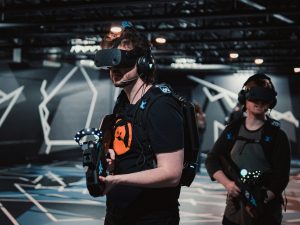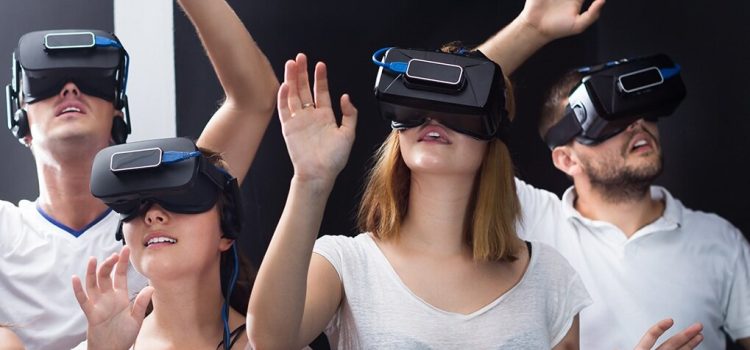
Introduction
The entertainment industry has always been at the forefront of technological innovation, continually seeking new ways to captivate audiences and enhance their experiences. One of the most transformative advancements in recent years has been the rise of virtual reality (VR). This immersive technology has revolutionized the way we consume media, offering unprecedented levels of engagement and interactivity. In this article, we will explore the various facets of VR’s ascent in the entertainment sector, from its early beginnings to its current state and future potential.
The Genesis of Virtual Reality

The concept of virtual reality is not new; its origins can be traced back to the mid-20th century. However, it wasn’t until the 1990s that VR began to gain traction in the public consciousness, thanks to early pioneers like Jaron Lanier, who coined the term “virtual reality.” Despite the initial excitement, the technology was limited by the hardware and software capabilities of the time, resulting in a period of stagnation.
Technological Advancements and Renewed Interest

The 21st century witnessed significant advancements in computing power, graphics, and sensor technology, reigniting interest in VR. Companies like Oculus, founded by Palmer Luckey in 2012, played a pivotal role in bringing VR back into the spotlight. The Oculus Rift, a groundbreaking VR headset, garnered widespread attention and was eventually acquired by Facebook in 2014 for $2 billion, marking a significant milestone in the rise of virtual reality.
VR in Film and Television

One of the most exciting applications of VR in entertainment is its integration into film and television. Filmmakers are now able to create immersive experiences that place viewers directly into the narrative. This shift from passive to active engagement has the potential to redefine storytelling.
1. VR Cinematic Experiences
Directors like Alejandro G. Iñárritu have experimented with VR to create compelling cinematic experiences. Iñárritu’s VR installation ” Carney Arena” allows viewers to experience the harrowing journey of immigrants crossing the U.S.-Mexico border, providing a visceral and empathetic understanding of their plight.
2.Virtual Reality in TV Shows
Television networks and streaming services are also exploring VR content. For example, Netflix has developed VR experiences for some of its popular shows, allowing fans to explore the worlds of “Stranger Things” and “Black Mirror” in a more immersive manner. This not only enhances viewer engagement but also opens up new revenue streams for content creators.
VR in Gaming

The gaming industry has been one of the earliest and most enthusiastic adopters of VR technology. The rise of virtual reality has fundamentally changed the gaming landscape, offering players unprecedented levels of immersion and interactivity.
1.Major VR Gaming Platforms
Several major VR gaming platforms have emerged, including the Oculus Rift, HTC Vive, and PlayStation VR. These platforms have given rise to a plethora of VR games, ranging from action-packed shooters to immersive puzzle adventures.
2.Popular VR Games
Games like “Beat Saber,” “Half-Life: Alyx,” and “The Elder Scrolls V: Skyrim VR” have set new standards for what VR gaming can achieve. These titles leverage the unique capabilities of VR to create experiences that are not possible on traditional gaming platforms.
VR in Live Events and Performances

Virtual reality has also made significant inroads into live events and performances. Artists, musicians, and event organizers are increasingly using VR to reach wider audiences and provide unique experiences.
1.Virtual Concerts and Festivals
The COVID-19 pandemic accelerated the adoption of VR for live events. Artists like Travis Scott and Marshmello have performed virtual concerts within video games like Fortnite, attracting millions of viewers. These events demonstrate the potential of VR to revolutionize the live music industry.
2. VR in Theater and Performing Arts
Theater productions are also exploring VR as a medium. Companies like the National Theatre in the UK have developed VR experiences that allow audiences to step into the shoes of characters and explore the narrative from different perspectives. This adds a new dimension to traditional theater, making it more interactive and engaging.
The Future of VR in Entertainment

As VR technology continues to evolve, its impact on the entertainment industry is likely to grow. Several trends and developments are worth noting:
1.Advancements in Hardware
Future VR headsets are expected to become more lightweight, comfortable, and affordable, making them accessible to a broader audience. Improvements in display resolution, field of view, and tracking accuracy will further enhance the immersive experience.
2.Integration with Other Technologies
The integration of VR with other emerging technologies, such as augmented reality (AR), artificial intelligence (AI), and haptic feedback, will unlock new possibilities. For example, AI can be used to create more realistic and responsive virtual characters, while haptic feedback can provide a sense of touch within virtual environments.
3.Expansion of VR Content
As the demand for VR content grows, we can expect to see a wider variety of experiences across different genres and mediums. From interactive documentaries to virtual theme parks, the possibilities are virtually limitless.
Conclusion
The rise of virtual reality in entertainment marks a significant milestone in the evolution of media consumption. By offering immersive and interactive experiences, VR has the potential to transform the way we engage with films, television, gaming, and live events. As technology continues to advance, the boundaries of what is possible in VR will only expand, promising an exciting future for both creators and audiences alike.










